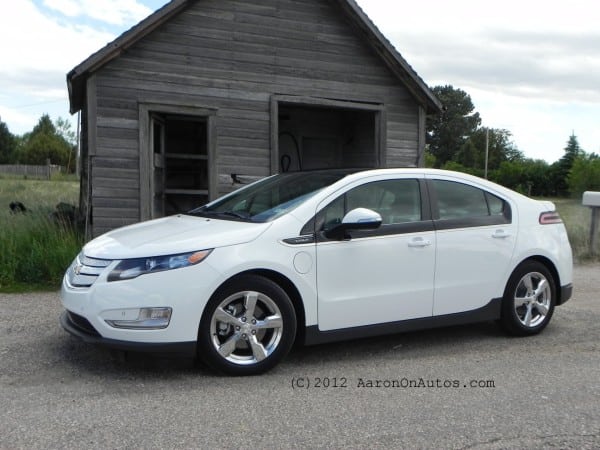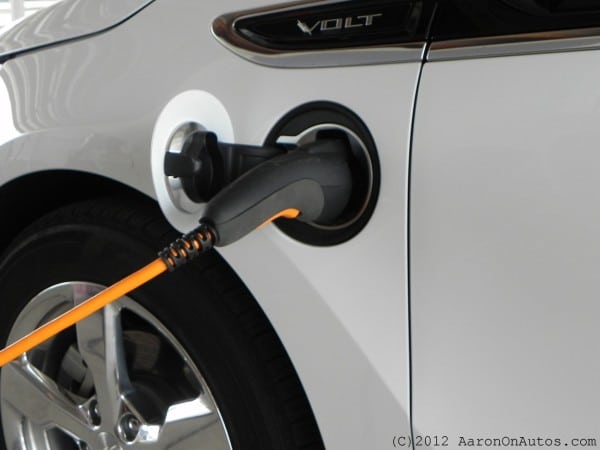Since its unveiling, and especially once it was announced for production, the Chevrolet Volt has been a controversial car. Much of the controversy surrounding the Volt has been perpetuated by misconceptions about the car.
Takes 40 Years or More To Pay For Itself
One persistent semi-myth is that the Chevrolet Volt will take forty years or more to make up its cost versus a gasoline counterpart. Usually the comparison is between the Volt and the Chevy Cruze upon which its platform is based.
This myth is persistent because it’s largely based on reality. Compared to the smaller, cheaper, and efficient Cruze, the Volt is definitely a price hog that will almost never make up the difference in fuel savings alone. The trouble with this comparison, fair as it may seem on the surface, is that the Cruze is an entry-level small sedan while the Volt is more of a premium model that borders on the entry-level luxury market in its fittings. No trim level of the Cruze comes even close to the technology options and fittings in the Volt.
With that said, the Volt’s price tag is firmly in the entry-level luxury vehicle range (before you start subtracting any government incentives). To make a fair comparison of the Volt versus a standard gasoline car, you would need to go to something more like the Ford Fusion or Toyota Avalon – both of which are available in high-end trim levels, but both of which are also much larger cars in terms of passenger space and cargo volume. Despite the Volt’s claim of being a “mid-sized sedan.”
Honestly, there is no fair apples-to-apples comparison in gasoline-only to pit against the Chevy Volt. Knowing all of that, however, we do know that were the Volt itself a gas-only vehicle, it would likely get in the 30-35 mpg range on the highway and cost about $27,000 at premium point (vs. about $44,000) – averages for the vehicle category the non-EV Volt would fit in. Using those numbers, we could calculate a price return rate of about four to six years – longer than the expected ownership lifespan of the average Volt owner, who is either leasing or are on 3-year trade-in cycles of vehicle ownership.
This is extremely simplistic, but few car buyers really do even this kind of rudimentary math when considering a purchase. Most will look at sticker price and whether or not the car fits their needs/wants. Add in the fact that the average Chevrolet Volt buyer has an annual income of about $170,000 per year – far above the national average – and you can see the point being made.
Volt Is Prone to Fires
This is an annoyingly persistent myth that is purely in the same realm as flying horses and Nazis on the moon. The fires that triggered this worry were induced by safety regulators testing the Volt and have never happened in the field or in standard testing. In order for the Volt to catch fire as it did in those tests, it would have to be rolled over and end up on its side (highly unlikely) and then be left on its side for at least two weeks so that the battery coolant could slowly break down the barriers preventing it from getting to the control electronics and then short those electronics out. Given that enough battery power is left at that point, the electronics can melt and start a fire.
The scenario is so unlikely that it’s far more likely that a stray bullet would pierce the gas tank in just such a way as to cause an explosion. A reality so far fetched that even the Mythbusters weren’t able to pull it off when attempting to prove the Hollywood movie staple.
Volt Gets 200+ MPG
4/14/2013 This section rescinded by the author, who concedes that his original premise was incorrect and who is not interested in re-writing this section to make it correct. Another really lame claim made by many a Volt owner about his or her purchase. For the Chevrolet Volt to actually get better than 200 MPG (or its equivalent), it would have to be driven completely on electricity at all times and never have its gas engine kick on, even excepting [edited 4/13/2013] for the automated precaution of fuel circulation.
Added 4/13/2013: No combustion engine in the world is capable of 200+ MPG. Not even the Volt’s. To include any other fuel source into the MPG measurement is to instead measure miles per gallon equivalent, not the actual MPG. This is what the Volt’s on-dash readout is giving, not actual MPG.
Most people don’t understand that combustion engines need to be exercised occasionally – storing a vehicle, even drained of fluids, will eventually cause the engine to become inoperable as seals break down and components rust. In the Volt, the problem is fuel going bad from sitting around for too long (added 4/13/2013: and engine fluids settling and “caking” or separating). So the car will automatically run the engine to burn fuel, even if the battery is fully charged, as an occasional measure to keep the fuel from separating or going sour. Because the Volt requires premium (high octane) gasoline, it is even more likely to suffer from gasoline storage problems. Added 4/13/2013: The engine must also run to provide heating or air conditioning for the passengers.
Claims of averaging over 200 MPG (some as high as 800 or more) over several months are just patently untrue. There is no way, pragmatically, that this could be done unless the fuel tank were completely drained (not a good idea long-term) and the vehicle were driven 100% electric. At that point, the owner may as well have just bought a much cheaper LEAF as they obviously didn’t need the much more costly extended range Volt. Over a month’s time, 200 MPGe or a little better may be possible, but that is hardly a long term metric.
The Volt Is the Greatest F’ing Car In the World
No car is the greatest in the world (..with perhaps the exception of the 2CV). The Volt has many limitations. While it has numerous proponents and many who seem ready to defend their purchase with their lives, the car is no better or worse than any other vehicle on the road.
Among its limits are:
- Seating for only four, despite being billed as a mid-sized sedan. The Volt is built upon the Chevrolet Cruze platform, which is a small car, not a mid-sized. The seating for four is because of the T-shaped battery – which runs down the center like a drive shaft in an older rear-wheel drive vehicle, but much higher – requires the rear seats to be split into two bucket seats rather than a bench. Further, space in the rear seating is limited and cargo space is severely limited.
- Is not efficient in many scenarios. Specifically rural living, where ground clearance is a must and highway driving is common. The Volt is made for city and stop-and-go traffic, not for long highway commutes at continuous speed. In the rural or long-distance case, it is more efficient than most cars, but not as efficient as a modern diesel or highway-efficient hybrid.
- It is costly. The Volt costs far more than any vehicle in the Prius line (including the plug-in) and more than most of the various iterations of the Ford Fusion.
- Styling is polarizing. Many (including the author) think the Volt’s looks are very unique and eye-catching. Others, however, think it ugly.
- Some of its proponents are like religious zealots. While misconceptions and incorrect statements about the Volt abound, often the most fanatic of its owners and proponents will relentlessly attack writers who disagree with the car or have reason to question its perfection. In the automotive press, we call them “Voltophiles.” They do more to make the car less appealing than they realize. These are similar to the “EVangelists” who cannot stand anyone saying anything negative about any electric vehicle at any time.
The Volt has its ups and downs. It’s not a perfect car – there is no such thing. Some may be capable of getting extraordinary mileage out of the vehicle and love its balanced drive while others may find it to be cramped and clunky. This is true of nearly any vehicle on the road.
The General Motors Bailout Paid for the Chevrolet Volt
This one is a volatile and often regurgitated myth in the media. It’s been repeated by everyone from Glenn Beck to Rush Limbaugh. It’s patently false almost in its entirety, but stays persistent because of repetition and the tiny kernel of truth contained within. That kernel is that the bailouts did keep GM in business and that, by implication, means it kept the Volt in business. Absolutely no money paid into GM by the government went directly into the Volt program or its manufacture. The majority of the bailout money paid was used to pay off other debts so that GM could become solvent again and stay out of bankruptcy.
In a similar vein, many claim that GM loses thousands per Volt produced. Mostly based on faulty accounting by Ben Klayman at Micheline (and repeated by others) – a claim that is easily debunked.
The Volt and EVs Get Us Off Foreign Oil
This is usually said with the implication that the “foreign oil” in question is from the Middle East. The truth is, it may get us off “foreign oil” if you’re talking about near-sourced imports like those from Canada or Mexico, but not from oil sourced from the other side of the globe.
The fact is, the U.S. imports less than 15% of its oil from Middle Eastern sources and the vast majority of that oil is used for things other than fuel – overall, the U.S. produces about 60% of its own oil, importing only about 40%. Most of those imports go into making plastics which are, by the way, one of the largest components by volume in the Volt – or any other car you wish to name. In fact, electric vehicles like the Chevy Volt use more plastic than do conventional combustion-only vehicles because the battery cases and associated hardware are largely made of plastic.
Even if we removed all domestic passenger vehicles from petroleum fuels, our imports from Saudi Arabia and Iraq (the two top Middle Eastern sources for oil in the U.S.) would not likely decline – so far, raised production levels domestically have meant that we have cut imports from Nigeria, Angola, and other more volatile African sources – not the Middle East. Oil imports from South America would also likely decline, but most of our fuels are actually made from domestically-sourced oil – often very near where it’s been extracted – or from Canadian oil imports. Where I live in Wyoming, for example, whole towns exist in and around oil refineries where the oil has been sourced nearby and is made into fuels and other items. These towns are sometimes named after the energy company that owns the refinery (Sinclair, Wyoming being a good example).
Conclusion
Like any car, the Chevrolet Volt is not a perfect solution for every consumer. It has its faults like any other vehicle does. For some owners, the price tag may be too high, the availability of plug-ins may be too sparse, or the car itself may be too small. For others, it may be the perfect commuter vehicle that can go to grandma’s on the weekends.
The politics surrounding the Volt are unfortunate. The car isn’t completely horrible, nor is it a “bailout machine” (at least, not directly or in a prove-able manner). It’s also not the green dream that many of its proponents might want to believe. In the end, it’s just another car. Innovative? Sure. Game changing? Probably not.
[nggallery id=67]









